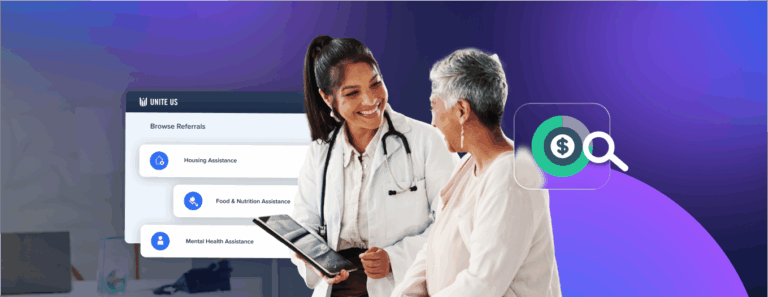
Introducing a Dynamic Social Needs System™ for Stronger Individual and Community Care Outcomes
Equipping health and social care stakeholders with the data accuracy and precision needed to strategically address social drivers of health (SDoH).
As the healthcare industry continues to shift to an integrated model that holistically addresses both medical needs and non-medical social drivers of health (SDoH), there is an increasing need for tools that measure social vulnerabilities to better inform resource allocation and targeted interventions.
Multiple models exist to measure social needs and community risk levels, but most standard measurements of social vulnerability aggregate data on a broad geographic level, from sources such as a census block, census tract, metropolitan statistical area, or county. This method often masks the needs of specific groups within an area.
As such, when it comes to tools that evaluate social needs, individual-level data is critical for enabling a holistic picture of patient health and ensuring that no one is left behind.
–
Tools for Measuring Social Needs
Several tools exist to measure social care needs, including the Social Vulnerability Index (SVI), the Area Deprivation Index (ADI), and the Social Needs System (SNS™), each with a unique focus.
What is the Area Deprivation Index (ADI)?
First developed by the Health Resources and Services Administration and later refined by researchers at the University of Wisconsin-Madison, the ADI is a mapping tool that displays neighborhoods’ relative socioeconomic conditions.
- How It’s Aggregated: The ADI is created from data captured in the one-year American Community Survey. It includes factors based on income, education, employment, and housing quality. The ADI is available at the census block level, with strong recommendations not to aggregate it at other geographic levels. The ADI is calculated at a single point in time and is based on data that is at least one year old.
- What it Measures: Assesses a region’s socioeconomic conditions, including factors like income, education, employment, and housing quality.
- How It’s Used: The ADI can be used to advance research on health disparities and inform policy interventions.
–
What is the Social Vulnerability Index (SVI)?
Developed in 2003 by the Centers for Disease Control and Prevention, the SVI helps identify communities that are most at risk during disasters, disease outbreaks, and other public health emergencies.
The SVI is a population-level measurement that assesses broader social, economic, and demographic factors to assess a community’s vulnerability to various external stressors and events, such as natural disasters, public health emergencies, or economic downturns.
- How It’s Aggregated: The SVI is created from data captured in the five-year American Community Survey. It includes factors on socioeconomic factors, demographic factors, household characteristics and housing type. The SVI is available at the census tract level and combines county level and census tract data. The SVI is calculated at a single point and was last refreshed in 2022.
- What it Measures: Highlights areas of potential weakness or risk in communities, helping to mitigate the impact of crises and enhance overall resilience.
- How It’s Used: Informs policy decisions and resource allocation around disaster preparedness and response planning.
–
Limitations of the SVI and ADI
Both the SVI and ADI have limitations in how they aggregate data, often leading to clinical gaps with care plans and other data silos.
- Overgeneralized Data: Relying on census block-level and census tract-level data can obscure socioeconomic disparities within smaller areas or within specific demographics, such as gender or age.
- Lack of Cultural Considerations: Some risk indicators, like housing conditions or unemployment, may not hold the same meaning across different cultural contexts.
- Lagging Data: They both are based on the American Community Survey data and are refreshed on an inconsistent schedule. This means risks could be based on data from years ago.
- Misuse in Resource Allocation: Policymakers may rely too heavily on the SVI in making decisions about resource allocation, without considering local expertise or additional data.
What is the Social Needs System™?
Introduced by Unite Us in 2018, the SNS is a proprietary framework designed to measure and address drivers of health (DOH). Recognized by the CMS, the framework relies on individual data to indicate the predicted level of social need.
SNS is an individual-level assessment that weighs how 12 factors, including food security, childcare needs, housing stability, employment, and other personal circumstances directly impact an individual’s health and well-being.
- How It’s Aggregated: Unite Us consolidates data silos to create a 360-degree view of an individual, incorporating demographic, geographic socioeconomic factors, and changes in an individual’s needs as they receive services. This allows us to meet each individual where they are in their social care journey and avoid taking a one-size-fits-all approach. By delivering dynamic insights into how services influence individual-level social needs over time, SNS enables organizations to proactively identify and respond to the unique needs of the individuals and communities they serve.
- What It Measures: Both the immediate, specific needs of an individual that the organization serves, often in a healthcare or social services context, and larger community needs in terms of geography, demographics, engagement preferences, and more.
- How It’s Used: Directs personalized care plans for individuals and informs policy decisions and resource allocation for communities at large.
–
Benefits of SNS™ Scores
SNS™ Scores can improve both individual and community health outcomes by providing:
- Tailored Interventions: Since SNS incorporates individual-level insights, it can be used to implement direct interventions and tailored care plans for individuals according to their social needs.
- Increased Efficiency: SNS can be directly integrated into existing workflows and care management systems. Organizations can prioritize resources and interventions for those most in need, and information about individual social needs can be shared among care teams, social service agencies, and community organizations, facilitating better coordination and avoiding redundant services.
- Decision-Making Support: SNS equips organizations with the data and actionable insights they need to understand both individual and community needs in a more precise and nuanced way, enabling more strategic decisions related to programming and funding.
- Improved Communication: Care leaders can also have more informed discussions with clients about their circumstances, building trust and promoting engagement in care plans for informed collaboration.
–
How We Made SNS Even Better
To improve our SNS models, we aimed to provide users with a more dynamic tool for understanding and addressing their client’s evolving needs as they change over time. By capturing changes in an individual’s needs as they receive services, our models deliver a richer and more accurate understanding of an individual’s social needs and how they change over time.
Unlike static indices, our dynamic scoring adapts to changes in an individual’s circumstances, providing a more accurate and timely reflection of their needs. This approach provides a more nuanced and actionable understanding of social needs, which is crucial for optimizing care management and addressing the specific challenges faced by individuals over time. By applying advanced data science tools and methodologies, we’ve created models that accurately predict social needs at both individual and community levels. These models outperform geographic risk scores by 3-9x at identifying poor health outcomes such as high total cost of care.
With SNS, healthcare systems, government agencies, health plans, and community-based organizations (CBOs) are empowered with dynamic, actionable insights into evolving social needs at both individual and community levels. With this insight into their communities, leaders across these organizations can address these shifting needs to improve outcomes, optimize resource allocation, and streamline care delivery for enhanced patient, public health, and community support.







